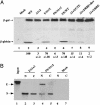Exon junction complexes mediate the enhancing effect of splicing on mRNA expression
- PMID: 12972633
- PMCID: PMC208756
- DOI: 10.1073/pnas.1934877100
Exon junction complexes mediate the enhancing effect of splicing on mRNA expression
Abstract
Intron-containing genes are generally expressed more effectively in human cells than are intronless versions of the same gene. We have asked whether this effect is due directly to splicing or instead reflects the action of components of the exon junction complex (EJC) that is assembled at splice junctions after splicing is completed. Here, we show that intron removal does not enhance gene expression if EJC formation is blocked. Conversely, RNA tethering of the EJC components SRm160 or RNPS1 boosts the expression of intronless mRNAs but not of spliced mRNAs. Splicing and RNPS1 tethering are shown to enhance the same steps in mRNA biogenesis and function, including mRNA 3' end processing and translation. Together, these data argue that the EJC is primarily responsible for the positive effect of splicing on gene expression.
Figures



References
MeSH terms
Substances
LinkOut - more resources
Full Text Sources
Other Literature Sources

